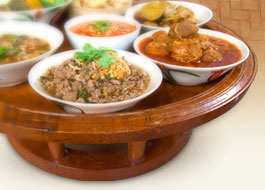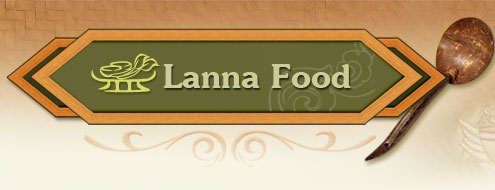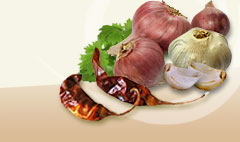Wing beans |
|
|
 | Psophocarpus tetragonolobus (Linn.) DC. |
|
| |
 | Leguminosae |
|
| |
 | Thua Pu (Chiang Mai); Thus Phu (Central) (Kanchana Diwiset, et al., 2005, 72) |
|
| |
 | Thua Pu (Chiang Mai); Thus Phu (Central) (Kanchana Diwiset, et al., 2005, 72) |
|
| |
 | Usually cultivated, annual, climber, 5 m. long. Leaves pinnate with petiole, 3 folioles, triangular-accuminate, 6 cm. wide, 10 cm. long. Inflorescence, axillary, peduncle, flowers papilionaceous, violet, pods linear 6-8 in. long, lenticular with 4 denticulate wings, surrated edge. (Kanchana Diwiset, et al., 2005, p. 72) |
|
| |
 |

Carbohydrates, fiber, protein, fat, calcium phosphorus, iron, A, B1, B2, C, E, Niacin. (Phak Phuen Ban A-han Phuen Mueang, 2007, 48). Lanna people eat the young pods with namphrik, yam pla chom, or made into a spicy salad with shrimp or kaeng Khae, khua khae. (Rangsan Chanta and Rattana Phromphichai, 1999, p.2640) |

Leaves have an oily taste, good for digestion of unsaturated fat. Pods are oily and cool, used to relieve heartburn and fever as well as boost energy. Roots are slightly bitter, can relieve stomach pain. Tubers are oily, cool and bitter and can revitalize energy and spirit as well as quench thirst. (Kanchana Diwiset, et al., 2005, p. 72; Wut Wuthithamwet, 1997, p. 223) and relieve fever (Wut Wuthithamwet, 1997, p. 223)
Lanna Pharmaceutical Indications: Many parts can be used. The tuber is used to treat some skin diseases, indigestion, sore throat, leukemia, burning heat around the temples, detoxification of all kinds, all types of cancer, dizziness, and toothache. Roots can reduce swollen gums, aural pain or ear ache, etc. (Rangsan Chanta and Rattana Phromphichai, 1999, p.2640).
|
|
| |
 | All year round |
|
| |
 |
Kanchan Diwiset, et al., Compiler. (2005). Phak Phuen Ban Phak Nuea. Pennapha Sapcharoen, Ed. 2nd ed. Nonthaburi: Thai Medicinal Text Development Center. (in Thai). RAngsan Chanta and Rattana Phromphichai. (1999). Thua Phu. In Saranukrom Wattanatham Thai Phak Nuea (Vol. 5, p. 2640 ). Bangkok: The Siam Commercial Bank Foundation for the Encyclopedia of Thai Culture. Wut Wuthithamwet. (1997). Saranukrom Samun Phrai: Ruam Lok Phesatchakam Thai. Bangkok: Odean Store. (in Thai). |
|
| |
|
|




